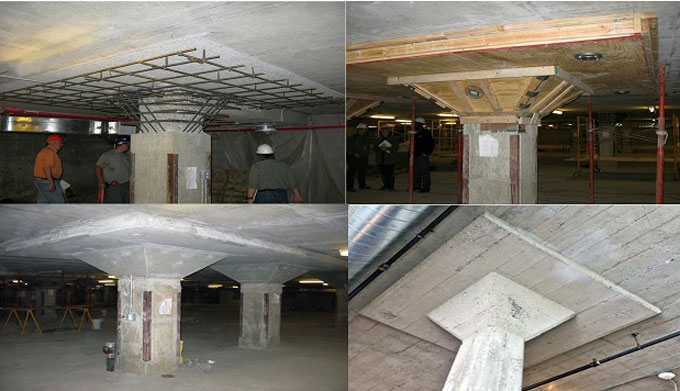
Advantages & Disadvantages of Flat Slab

Normal process of design and construction is to support the slabs with beams and support the beams with column. It is known as beam-slab construction.
The beams help in minimizing the existing net clear ceiling height. Often, in warehouses, offices and public halls, the slabs are used as a substitute of beams and they are directly supported with columns. These types of slabs are known as flat slabs.
A flat slab stands for a one-way or two-way system with solidities in the slab at the columns and load bearing walls are known as ?drop panels? Drop panels function as T-beams over the supports. They raise the shear strength and the rigidity of the floor system against vertical loads, thus the economical span range becomes greater.
Normally, the height of drop panels remains about two times the height of slab. The plan dimensions of the drop panels are a minimum of 1/3 of the distance in the direction being considered, normally rounded to the nearest 100 mm.
Flat Slabs are useful for most of the construction and for irregular column layouts like floors having curved shapes and ramps etc.
Types of Flat Slab Construction - Following types of flat slabs are commonly used in construction:
1. Simple flat slab
2. Flat slab with drop panels
3. Flat slab with column heads
4. Flat slab with both drop panels and column heads
The major features of a flat slab floor are a flat soffit, simple formwork and smooth construction. The economical span ?L? of a reinforced concrete flat slab is roughly D x 28 for simply supported, D x 32 for an end span and D x 36 for an interior span. Pre-stressing the slab raises the economical span to D x 35, D x 40 and D x 45 respectively, where D stands for the depth of the slab without the drop panel.
Benefits and Drawbacks of Flat Slabs
Benefits:
? Easy formwork
? No beams?streamlining under-floor services outside the drops
? Least structural depth
? Normally, shear reinforcement is not necessary at the columns.
? Saving in the height of the building
? Construction time is reduced
? Application of prefabricated welded mesh
Drawbacks:
? Medium extents
? Normally not ideal for supporting brittle (masonry) partitions
? Drop panels may obstruct with larger mechanical ducting
? Vertical penetrations should circumvent area around columns
? For reinforced flat slabs, deflection at the middle strip becomes important.


